For Super Sleuth DC Fans: An ongoing look at 86 years of DC Comics, beginning with New Fun #1, January 11, 1935 through March 1938.
Contributor mini bios: Richard Loederer, Bert Salg, Bob Weinstein, Lawrence Lariar, Adolph Schus, Lyman Matthew Anderson
Major Malcolm Wheeler-Nicholson’s New Fun #2 appeared on newsstands on February 8, 1935–85 years ago a little less than a month after New Fun #1 on January 11. It was followed a month later by New Fun #3 on March 8, 1935. The Major stated in the forced bankruptcy case that they were working 3-4 months ahead. Lloyd Jacquet in the 1957 article—“The Coming of the Comic” noted that the Major “set up his card table and chair in an eleventh-floor office of the Hathaway Building in New York that Fall of 1934….” With those dates, more than likely they began putting together New Fun #1 sometime in late September 1934 or early October 1934, following with New Fun #2 and New Fun #3. If you consider September 1938 as the final chapter in the Major’s era that’s a four-year period that birthed an entire industry.
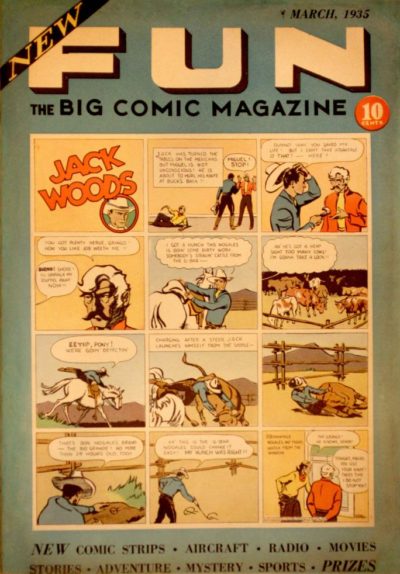
New Funs #1-6 are quite rare. Few scholars and historians have seen them much less the larger fan base. It is only through the recent generosity of a few collectors providing digital copies that I have been able to examine them closely. The digital copies are sometimes hard to read and there are pages missing here and there so there are a few things of which I cannot be certain. The prose articles are unsigned and often many of the comics are unsigned but there are clues and the continuity helps as well.
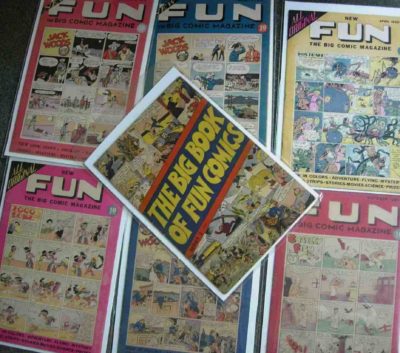
From Jon Berk collection.
Reading these rare comics magazines there are three basic themes that continually jump out to me. One is the rapidly evolving innovations that occurred during this period that laid the foundations of comics as we know them. The second is the burst of creativity by the artists and writers involved and the third is the hidden clues to the structure of the business and subsequent industry including the financial foundation.
The cover for New Fun #1 on a red background had the logo Fun in large lettering with New at a diagonal and underneath The Big Comic Magazine. It featured the comic “Jack Woods” in color illustrated and signed by Lyman Anderson consisting of four strips of 3 panels. The footer at the bottom emphasized New Comics Strips, Aircraft, Radio, Movies and below Stories, Adventure, Mystery, Sports and Prizes. The interior was in black and white.

New Fun #2, on what I’m guessing to be a teal background, as shown above, followed the exact same format with the Jack Woods comic continued.
The cover for New Fun #3 was slightly different. It was on a yellow orange background featuring “Don Drake on the Planet Saro” in color illustrated by Clem Gretter, written by Ken Fitch. The monster with comically red lips is prominently in the middle of the page. Was it intentional so as to entertain children or simply a struggle with coloring the comic?
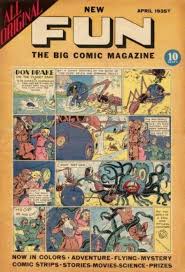
Although there were 4 strips of panels on the cover of New Fun #3 they were no longer symmetrical. The size of each panel contributed to the movement of the story. “New” was now in smaller letters above FUN and on the diagonal was All Original. The footer consisted of “Now in colors, Adventure, Flying, Mystery” and below “Comic strips, Stories, Movies, Science, Prizes.” It’s clear from the very beginning that the emphasis was on new and original comic strips.
The inside front cover for both New Fun #1 and #2 also followed the same format. The gnome referred to as FUN illustrated by Dick (Richard) Loederer shouts out the information in New Fun #1—“New Fun, Hello Everybody: Here’s the New Magazine You’ve Been Waiting For!” The characters featured in the comic strip Pelion and Ossa—a penguin and polar bear, also appear, which makes me wonder if that comic was also drawn by Loederer. The contents of the magazine appear on a sidebar with the masthead underneath and the statement of ownership. From the articles I’ve read in the New Funs, and Lloyd Jacquet’s writing style from the promotional letter sent out for New Fun #1, I’m guessing he wrote the content for the first page as well.
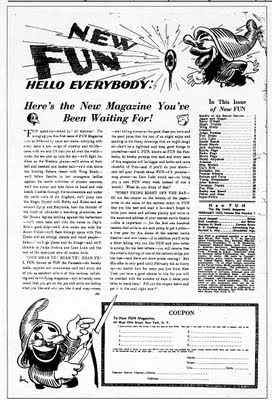
From the onset the magazine offered prizes to the first 100 readers who wrote in. They will be given five free passes to their nearest movie theatre. Was that a tie-in with Universal Studios? The other prize, which is the forerunner of all the artists in artist alley at various conventions is that the ten best letters will receive “…free the artist’s drawing of one of the cartoon strips you like best…” The Major considered the artwork to have value as a prize.
The masthead and statement of ownership is exactly the same for New Fun #1 and 2. However, I could not find either in New Fun #3 although Lloyd Jacquet was listed as editor above the contents. The digital copy I have does have a page that is cut but given the other side of the cut it’s hardly likely to have been on that page. Maybe it appeared on the inside of the front or back.
Unlike New Fun #1 and 2, a good portion of the pages for New Fun #3 were in color. Pages in the center of the magazine, mainly consisting of articles and prose stories were in black and white. The layout of the magazines is also revealing. Some of the comics stories fill the tabloid sized pages but others do not and require a filler at the top or bottom. Perhaps the Major or Jacquet was able to discuss the size of the comic with some artists and others were simply submitted. Most of the ads appear in the section of articles. Since the mock-ups were worked on about 3 months ahead of the printing and distribution, it’s easy to see why slight changes began with New Fun #3. By that point they were getting feedback from readers and having a better idea of sales.
Of all the artists who contributed to the New Funs, Dick (Richard) Loederer is the most influential. He contributed to the look of the magazines by designing all the logos for the different pages and did a number of illustrations for the various articles. I’m guessing he also designed the logo for FUN as it fits the style of the rest of his artwork. He also contributed several comics and deserves to be better known to the larger DC fan base.

Unlike some of the other artists who simply submitted their work there is a sense Loederer collaborated with the Major in the new comics magazine. His comic “Brad Hardy” appearing in New Fun #3 is so similar to many of the Major’s adventure stories that take place in Mongolia and Tibet. The filler right above “Brad Hardy” drawn by Loederer features information on Tibetan religious customs, one of MWN’s interests and studies.
Loederer contributed several comics—”Bubby and Beevil” featuring the Fun Gnome and “Caveman Capers” both aimed for children. I believe he contributed the concept for “Fun Films” illustrated by Adolphe Barreaux which featured cut out strips that could be pulled through a frame. In 1928 he created a Movie Book for children with the case fashioned like a book and a window on the top cover that created the screen. A prolific and varied artist Loederer painted murals for the WPA, worked in films, advertising, publishing as an editor and for The New Yorker as creative editor. Loederer also illustrated books and his book Voodoo Fire in Haiti features distinctive woodcuts. He was truly one of the pioneers of the Modern Era of Comics.

Bert Salg’s comic “Judge Perkins” appeared in New Fun #1 and #2. Drawn in a distinctive style Judge Perkins was a bumbling character who, mistaking a bull for a person, ends up in a lake and is rescued. It filled the full tabloid page for both NF #1 and 2. Salg did no other work in comics as far as is known. He was noted as the sole illustrator for Leo Edward’s books including the Poppy Ott series.

The comic “Cap’n Erik” only appeared in New Fun #1 and #2. Bob Weinstein was the creator and had a couple of insets framed by sailing rope providing information on Henrik Hudson’s Half-Moon and Leif Ericsson’s the Red Rover. When I was researching contributors for DC’s reprint of New Fun #1, I had a hard time finding much on Bob Weinstein. His only other contribution to comics was a strip for the George Matthew Adams Service “Cap’n Cloud.” I’ll bet it was similar to “Cap’n Erik.” I finally pieced together enough information to discover he was most known for his illustrations for a 1964 reprint of Two Years Before The Mast. Obviously, he was someone who loved sailing and the sea.
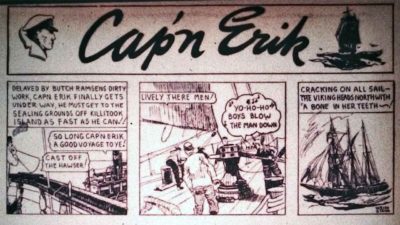
Barry O’Neill and Fang Gow, characters created by the Major was initially drawn by Lawrence Lariar for “Barry O’Neill” in New Funs #1 and 2. Lariar’s style in the black and white format is especially fine work. “Barry O’Neill was continued in New Fun #3 in color and illustrated by Ed Stevenson who made his first appearance in New Fun #3. The title, no longer simply Barry O’Neill reads “In Far Off China sits Fang Gow the inscrutable and vengeful enemy of the human race. Who is He? What is He?” Stevenson’s style is sophisticated and the coloring does his work justice.
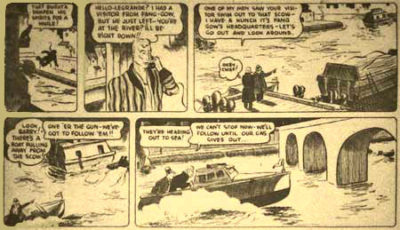
Lariar studied art at the New York School of Fine and Applied Arts and with his friend Adolph Schus attended the Academie Julien in Paris. Obviously Lariar brought Schus into the world of New Fun. He and Schus along with Jack Arthur started a cartoon agency after graduation. A short paragraph doesn’t do justice to his long career. He was a prolific artist and writer and appeared in many New York daily newspapers as well as magazines like Saturday Evening Post, Collier’s and The New Yorker. An intriguing graphic novel by cartoonist Bill Griffith was recently published–Invisible Ink: My Mother’s Love Affair with a Famous Cartoonist about Lariar and his affair with Griffith’s mother. It’s well worth a read and my only quibble is that like so many others Griffith mistakenly attributes the creation of Barry O’Neill to Lariar. That’s one of the reasons you can’t write about the Major’s early comics without knowing his pulp adventure background and stories.

Lariar’s pal Adolph Schus contributed “Jigger and Ginger” for New Fun #1 and 2 and was discontinued thereafter. He also contributed a page of “Comic Shorts” for New Fun #3, which were in black and white and may have simply been a holdover submission. “Jigger and Ginger” is a comic similar to the later “Archie” comic aimed for teenagers. The artwork has a New Yorker feel to it. The comic features the antics of Jigger and rich bad boy Kip to outdo one another in dating Ginger. Schus had a long career in magazine publishing as an illustrator for The New Yorker, Collier’s and College Humor. He was an editor of Pageant Magazine.

The comic “Jack Woods” initially drawn by Lyman Matthew Anderson for New Fun #1 and 2 continued in New Fun #3 illustrated in color by William Clarence Brigham, Jr. who made his first appearance in New Fun #3. Anderson also contributed to the comic “Jack Andrews” in New Fun #1 and 2, and most likely as Bill Leyman for New Fun #3. Since some pages in New Fun #3 were in black and white, I’m guessing the Jack Andrews comic had already been drawn. Why Andrews used a pseudonym is not known.

Anderson studied at the Art Institute of Chicago and in New York at the Grand Central School of Art. Lyman Anderson is one of the many pulp connections in these early comics. He began illustrating pulps in 1929 for Battle Stories, Ace-High, Dime Western and Thrilling Detective Stories among others and created cover paintings for many as well. His other comics work was for King Features Syndicate illustrating “Inspector Wade.” He later illustrated for Cosmopolitan, Saturday Evening Post and others and taught at The Famous Artists School in Westport, Connecticut.
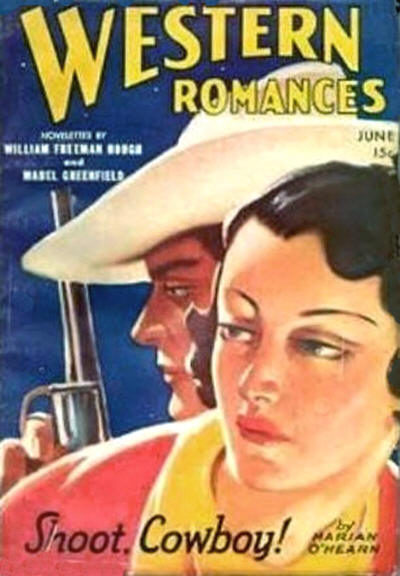
One of the more mysterious biographies of this period involved Adolphe Barreaux and he deserves his own post to follow.
“Sandra of the Secret Service” again occupied prime real estate in New Fun #2 and 3. For New Fun #3 she was drawn in color without an artist’s signature. In comparing some of the other artwork throughout New Fun #3, it’s possible Ed Stevenson drew it as well since it has a sophisticated style. Sandra, although a precursor in some ways for Wonder Woman, is similar to Batman in that she is human and not superhuman. She continued throughout the Major’s era and we’ll return to her.
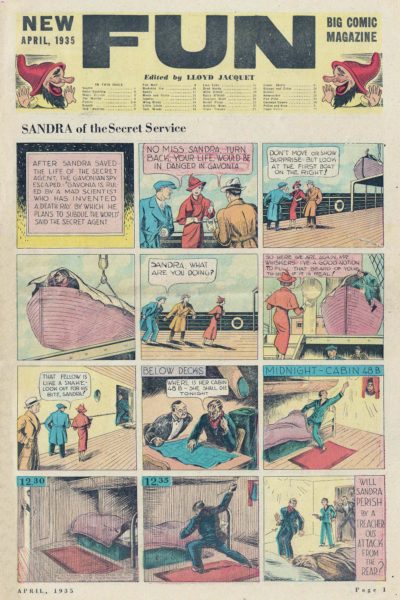
There were 29 features in New Fun #1, 31 listed in New Fun #2 and 29 in New Fun #3 including in addition to the comics, prose stories, articles and activities for children.
New contributors to the comics were arriving on the scene. Two who were to become legendary were Whitney Ellsworth appearing in New Fun #2 with his comics “Sonny” and “Little Linda” and Vincent Sullivan appearing in New Fun #3 with his comics “Pincus” and “Spike Spalding.”

The magazines were evolving with color added, new features and younger artists. A new industry was forming. Will your Majorette make it to the full run of New Funs before we say goodbye to 2020. Tune in and find out!
